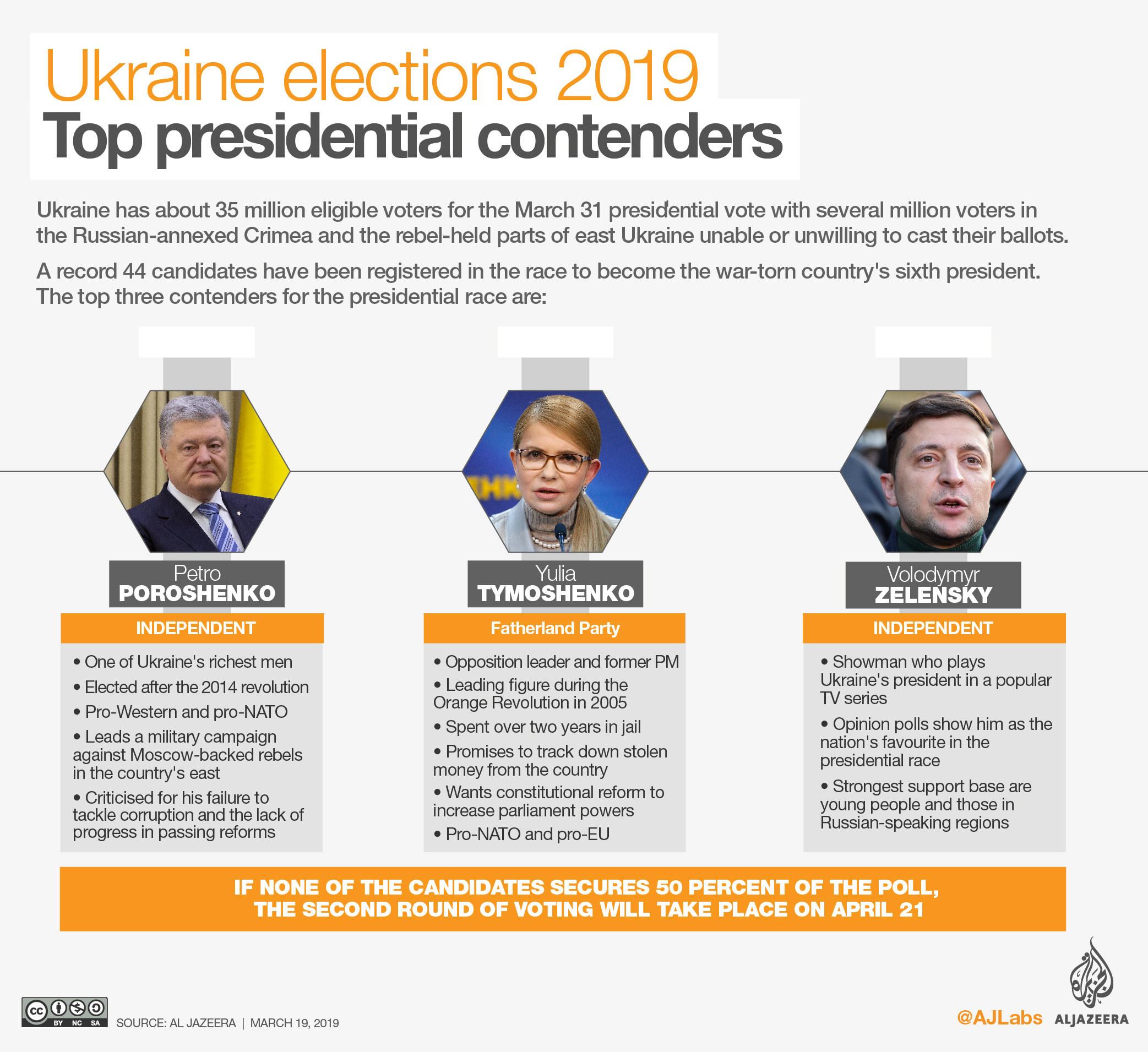Ukraine presidential election: All you need to know
More than 35 million people are eligible to vote in Ukraine’s presidential election on March 31 – the first electoral test for President Petro Poroshenko since he came to power in 2014 on a wave of pro-Western protests.
However, several million of the voters in the Russian-annexed Crimea and the rebel-held parts of east Ukraine are unable or unwilling to cast their ballots.
The central election commission has registered a record 44 candidates, although one of them later dropped out.
According to opinion polls, three hopefuls stand a chance to become the war-torn country’s sixth president.
They consist of: Poroshenko, a billionaire with a chocolate empire who is also known as the Chocolate King; opposition leader Yulia Tymoshenko, once a natural-gas magnate which earned her a nickname Gas Princess; and a comedian, Volodymyr Zelensky, who has no political experience.
Main contenders
In a country riddled by corruption and torn apart by armed conflict, the majority of Ukrainians appear to be tired of mainstream politicians and have propelled the comic, Zelensky, to the top of the polls.
The 41-year-old, who is best known for playing the lead in the political comedy “Servant of the People”, has about 25 percent of the voters’ support – well ahead of Poroshenko (almost 17 percent) and Tymoshenko (more than 18 percent).
According to the non-governmental polling organisation Rating Group, the majority of Zelensky’s supporters are young people between 18 to 25 years old and live mostly in the Russian-speaking parts of Ukraine, the southern and eastern regions.
Poroshenko, 53, who was elected with almost 55 percent of votes in 2014, seems to have failed to rally his electorate despite his efforts to be seen as a passionate fighter for the country’s territorial unity as well as the champion of Ukraine’s dream of integration with the European Union and NATO.
 |
Over the last five years, he reinforced the Ukrainian army that battles the Moscow-backed rebels in Ukraine’s Donetsk and Luhansk regions.
Poroshenko also ratified the Association Agreement with the European Union, the document that enabled Ukrainians to trade with and travel to Europe without restrictions.
|
Why has Ukraine’s Orthodox church split from Russia? (25:00) |
The incumbent president also secured the independence of Ukraine’s Orthodox Church from its Russian counterpart.
But he failed to rid the country of corruption or recover the money stolen from Ukraine’s coffers during the years that Viktor Yanukovich ruled the country.
Ukrainians blame Poroshenko for the lack of reforms and the deterioration of the living standards since 2014.
He will face another heavyweight, Tymoshenko, for the second time in the presidential race.
Tymoshenko, who served twice as prime minister under different presidents in 2005 and 2007, was defeated in the presidential race in 2014 by Poroshenko, but has a higher chance of winning over him this time around.
The 58-year-old is well known for her fiery rhetoric – she was a leader of the pro-Western 2004-2005 Orange Revolution – and is popular with older voters as she promises a threefold increase in pensions.
Tymoshenko also promised the Ukrainians to track down money stolen over the years from the country’s coffers during the rule of Yanukovich who was ousted through deadly protests in 2014.
She has spent more than two years in prison under Yanukovich on corruption charges that she said were politically motivated.
Election preparations
More than 967 registered international observers will monitor the vote on March 31, according to the election commission.
If none of the candidates secure 50 percent of the vote, a second round of voting will take place on April 21.
Ukraine’s SBU security service has reinforced the country’s defences against any cyber attacks ahead of the vote. It held joint EU-Ukraine cyber security drills this month.
The SBU has said that several Russian cyber attacks against the central election commission had recently taken place and more were expected.
The Ukrainian Election Task Force, a group set up with the help of the Atlantic Council, a US think-tank, to expose foreign interference attempts, said Russians might also target critical infrastructure such as power grids, telephone networks or airports.
Ukraine’s ties with Russia were broken with the ouster of Moscow-backed Yanukovich that prompted the annexation of Crimea and Russia’s support of the rebels who seized parts of Donetsk and Luhansk.
The conflict has killed at least 13,000 people.
|
Waiting For Invasion | Witness (47:00) |




